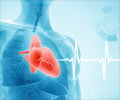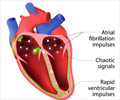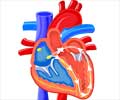Atrial and Junctional Arrhythmias
Atrial Arrhythmias
In Atrial Arrhythmias the cause of the arrhythmia is in the upper chambers of the two atria.
- Sinus Tachycardia is increase in heart rate up to 140 beats per minute. This is a normal response to exercise and stress. Exercise can even increase heart rate up to 200 beats. Heart rate comes down when you cool down.
- Sinus Bradycardia is decrease in heart rate, less than 60 beats per minute. It is normal for athletes to have a slower rhythm. Diseased sinus node can be one of the reasons for slower heart rate. It can also happen due to certain medications like the beta-blockers or calcium channel blockers used for hypertension or for improving hearts function.
- Atrial Flutter is when the atrium beats at 250-300 beats per minute. The impulses slow down at the AV node. Not all atrial beats are transmitted to the ventricles. Every second beat traveling to the ventricle causes a heart rate of about 150. Sometimes the heart rate is normal as the AV node only passes every third or fourth beat down. Atrial flutter can be present at all times or may just come and go. Since the atria do not pump efficiently, the blood supply to the body is reduced. Patients often present with fatigue, syncope, light-headedness, chest pain and/or shortness of breath along with palpitations. In the United States, about 200,000 patients present with atrial flutter every year. Atrial flutter occurrence is almost twice in men than women. Medications to control the arrhythmia will be started when you are diagnosed with atrial flutter. Immediate medical attention is required in patients with severe symptoms. For example, people with heart failure may need IV medications to control atrial fibrillation. Chronic or long standing atrial fibrillation patients will be on anticoagulants to prevent thromboembolism. They may need “DC Cardioversion”. This is a procedure where the patient is fully sedated with anesthesia and a defibrillator is used to shock the heart to bring the rhythm back to normal. Radio frequency ablation can be tried to treat atrial flutter if medications do not work.
- Atrial fibrillation [AF] is a disorganized quivering of the atria. It is the most common arrhythmia reported. About 2.2 million Americans have atrial fibrillation and approximately 15% of these patients have strokes. However, the incidence is much higher in countries like India, where rheumatic heart disease [RHD] still prevails in large numbers. Mortality and Morbidity is high in young adults with RHD and AF, whereas an older population is affected by atrial fibrillation in the western countries. Since the atria do not completely empty the blood, pooling occurs and leads to clot formation. Thus, atrial fibrillation can lead to thromboembolism.
Heart failure and Myocardial infarction can be complications because of the reduced cardiac output. Hypertensions, Hypoxia and Hyperthyroidism are some of the predisposing factors to atrial fibrillation. It can be a chronic or intermittent condition. Patients need to be on Antiarrhythmic medications to control the rhythm and the ventricular rate. Anticoagulants medications are required to prevent thromboembolism. Like atrial flutter, Cardioversion is indicated on patients with chronic atrial fibrillation to convert their rhythm to sinus. Radio Frequency Ablation (RFA) can be attempted to treat atrial fibrillation when medications do not work.
- Supraventricular Tachycardia (SVT) is rapid heartbeats originating anywhere above the ventricles. It usually starts at a young age. All the atrial and Junctional tachycardias can be collectively called Supraventricular tachycardia.
SVT is divided into two types. If there is an accessory pathway between the atrium and the ventricle, the electrical impulses can travel through it and alongside the normal conduction to the AV node. This abnormal conduction can be either from the atria to the ventricles or may cause reentry to the atria from the ventricles. Wolf-Parkinson White (WPW) is a common abnormality with an accessory pathway. This re-entry phenomenon is called “Atrio-Ventricular Reentrant Tachycardia” or AVRT. Supraventricular tachycardia does not always have an accessory pathway connecting the atria and the ventricles. The electrical impulses can travel through extra fibers in a circle around the Atrio ventricular node. The reentry is referred as “Atrio-ventricular Nodal Reentrant Tachycardia” or AVNRT. Radiofrequency ablation has been successful in treating WPW syndrome and other arrhythmias caused due to accessory pathways.
- Premature atrial Contractions (PAC) are extra beats starting from somewhere in the atrium, but not from the Sinus node, the pacemaker. This causes a feeling of skipped beats, usually induced by stress or caffeine. Less than 50% of the people with PACs feel it. It is not usually harmful. They may last all life and does not require any treatment if it does not compromise the quality of your life.
- Sick Sinus Syndrome (SSS) is where the sinus node is not functioning properly. It is common in older people and is a progressive disease. Slow heart rate or bradycardia is usually associated with this syndrome. Every 3 out of 10,000 people are affected with it. Patients can be without symptoms for a while. Progressed sick sinus can cause palpitations, dizziness and syncope. Pacemaker implantation is the mainstay of treating the symptoms.
Junctional Arrhythmias
Junctional arrhythmias are most commonly benign. They originate at the junction of the atrium and ventricles. Low potassium and digitalis toxicity can cause these rhythms. Treating the cause usually reverts the rhythm back to normal sins rhythm.






















